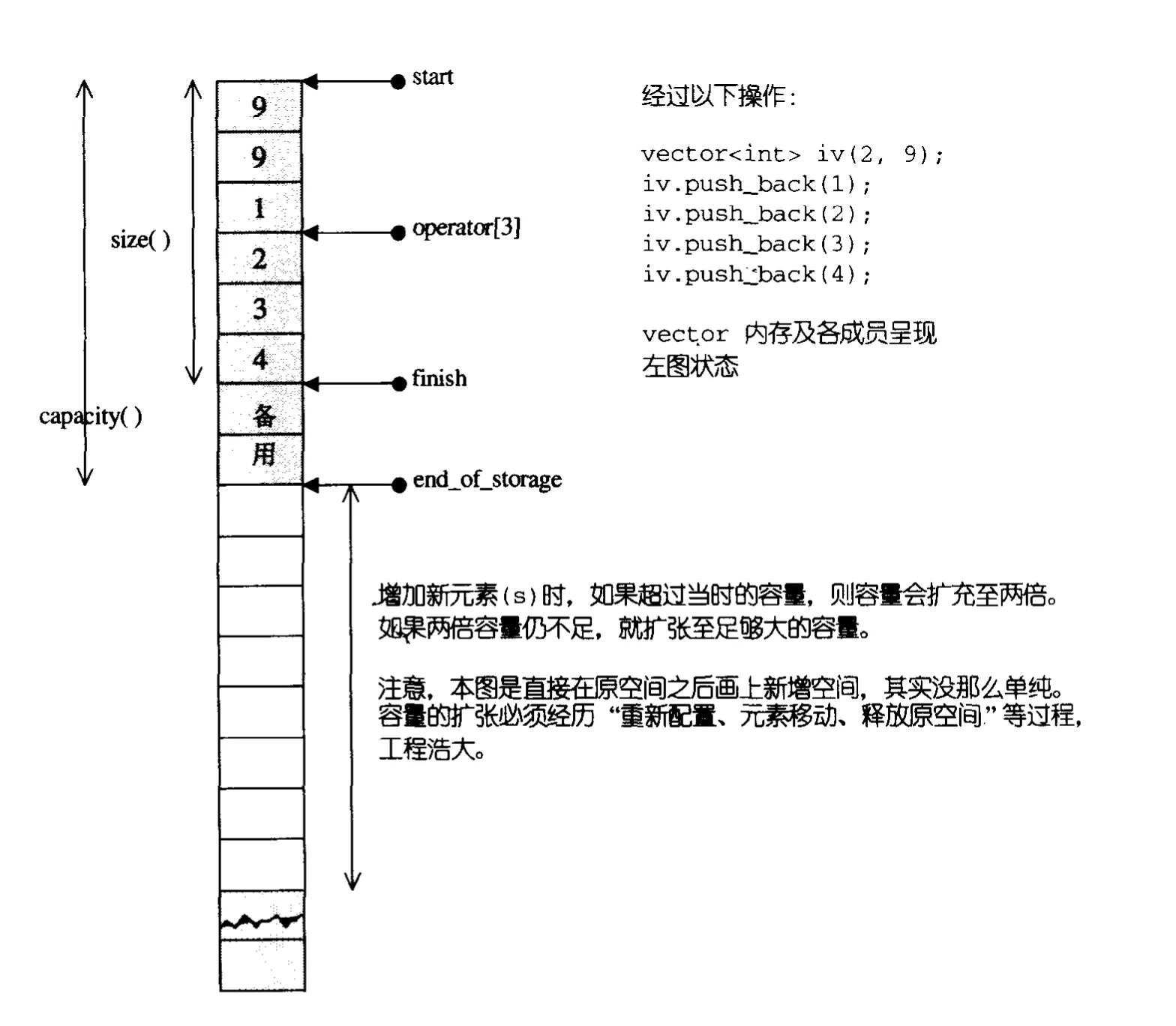std::vector::push_back 内存是如何动态增长的:增加新元素,如果超过当时的容量,则容量会扩充至原来的两倍。
1. 概述
std::vecotr 有自己的动态内存分配策略,策略有优点也有缺点,只有充分理解它们才能更好地使用。
- 优点:避免频繁向底层分配空间,增加开销。
- 缺点:内存动态增长幅度比较大(2 倍),可能会浪费空间。而且数组是连续的内存空间,内存空间增长需要创建新的连续空间,涉及到内容拷贝,某些场景会增加系统开销。

图片来源:《STL 源码剖析》– 侯捷 – 第四章 - 序列式容器 - 4.2 vector
2. 源码分析
我们通过 C++11 的 std::vecotr::push_back 接口源码,看看 std::vecotr 是怎么扩充内存的,空间分配大小核心在接口 _M_check_len。
1
2
3
4
5
6
7
8
9
10
11
12
13
14
15
16
17
18
19
20
21
22
23
24
25
26
27
28
29
30
31
32
33
34
35
36
37
38
39
40
41
42
43
44
45
46
47
48
49
50
51
52
53
54
55
56
57
58
59
60
61
62
63
64
65
66
67
68
69
70
71
72
73
74
75
76
77
78
79
/* stl_vector.h */
template <typename _Tp, typename _Alloc>
struct _Vector_base {
typedef typename __gnu_cxx::__alloc_traits<_Alloc>::template rebind<_Tp>::other _Tp_alloc_type;
typedef typename __gnu_cxx::__alloc_traits<_Tp_alloc_type>::pointer pointer;
struct _Vector_impl : public _Tp_alloc_type {
pointer _M_start; /* 目前使用空间头部位置。 */
pointer _M_finish; /* 当前使用空间尾部位置。 */
pointer _M_end_of_storage;/* 目前可用空间尾部位置。 */
}
...
};
/* 追加元素。 */
template <typename _Tp, typename _Alloc = std::allocator<_Tp> >
class vector : protected _Vector_base<_Tp, _Alloc> {
...
/* 追加元素,如果还有空间继续追加内容,否则分配新的空间,处理内容。 */
void push_back(const value_type& __x) {
if (this->_M_impl._M_finish != this->_M_impl._M_end_of_storage) {
_Alloc_traits::construct(this->_M_impl, this->_M_impl._M_finish, __x);
++this->_M_impl._M_finish;
} else {
#if __cplusplus >= 201103L
/* c++11 */
_M_emplace_back_aux(__x);
#else
_M_insert_aux(end(), __x);
}
#endif
}
...
size_type _M_check_len(size_type __n, const char* __s) const {
if (max_size() - size() < __n)
__throw_length_error(__N(__s));
/* 一般情况下就是两倍空间。 */
const size_type __len = size() + std::max(size(), __n);
return (__len < size() || __len > max_size()) ? max_size() : __len;
}
};
/* vector.tcc */
#if __cplusplus >= 201103L
template <typename _Tp, typename _Alloc>
template <typename... _Args>
void vector<_Tp, _Alloc>::_M_emplace_back_aux(_Args&&... __args) {
/* 检查空间长度,返回合适的长度。 */
const size_type __len = _M_check_len(size_type(1), "vector::_M_emplace_back_aux");
pointer __new_start(this->_M_allocate(__len));
pointer __new_finish(__new_start);
__try {
/* 创建新空间,将数据写入新空间,旧空间内容复制到新空间。 */
_Alloc_traits::construct(this->_M_impl, __new_start + size(), std::forward<_Args>(__args)...);
__new_finish = 0;
__new_finish = std::__uninitialized_move_if_noexcept_a(
this->_M_impl._M_start, this->_M_impl._M_finish, __new_start, _M_get_Tp_allocator());
++__new_finish;
}
__catch(...) {
if (!__new_finish) {
_Alloc_traits::destroy(this->_M_impl, __new_start + size());
}
else {
std::_Destroy(__new_start, __new_finish, _M_get_Tp_allocator());
}
_M_deallocate(__new_start, __len);
__throw_exception_again;
}
/* 释放旧空间。 */
std::_Destroy(this->_M_impl._M_start, this->_M_impl._M_finish, _M_get_Tp_allocator());
_M_deallocate(this->_M_impl._M_start, this->_M_impl._M_end_of_storage - this->_M_impl._M_start);
/* 位置指向新空间。 */
this->_M_impl._M_start = __new_start;
this->_M_impl._M_finish = __new_finish;
this->_M_impl._M_end_of_storage = __new_start + __len;
}
#endif
3. 小结
- 「源码面前,了无秘密。」 ———— 向侯捷先生学习。
- 从源码可以看到,std::vector 追加元素,会动态扩展空间。如果我们使用 std::vector 添加大量元素,会涉及内存频繁地扩展,内容频繁地拷贝。如果增加的内容可以预期的,我们可以考虑通过
resize接口一次性给 std::vector 分配预期的内存空间,避免逐步扩展带来的性能开销。
4. 参考
- 《STL 源码剖析》
- 序列容器之vector


